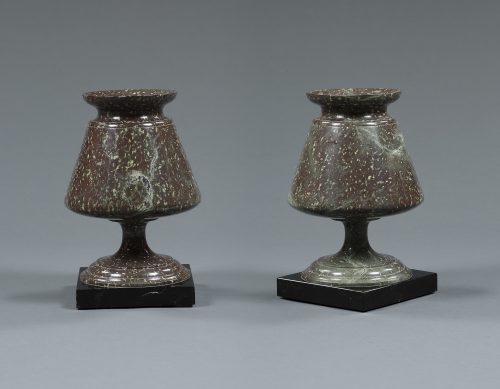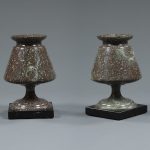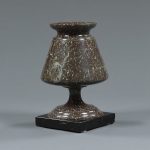11480 PAIR OF CORNISH SERPENTINE STONE URNS OF UNUSUAL FORM England. Second Half of the Nineteenth Century. Measurements: Height: 13 1/2″ (34 cm) Diameter 8 3/4″ (22 cm).

Research
Of serpentine and black marble. Each vase surmounted by a flared rim above an outwardly widening conical body raised on a turned socle and resting on a square black marble plinth. Old repairs to necks.
This pair of urns was turned from a valuable stone called serpentine. While it occurs worldwide, this particular variety is found chiefly on the Lizard Peninsula of Cornwall. It is formed in an “almost endless” variety of hues; “the predominant colour is olive green, but this is diversified by waving lines of red and purple, by seams of white steatite or soapstone, and by incrustations of yellow lichen.”1 Sir Henry de la Beche described the stone in his Geological Observer (1839) as “extremely beautiful, particularly where veins of red traverse the olive-green ground, mixed with lighter tints” and “…a very hard and beautiful variety, having a reddish base studded with crystals of diallage, which, when cut through and polished, shine beautifully of a metallic green tint, in the reddish base.”2
The stone had been used locally in a rudimentary manner, but in the 1828 a Mr. Drew of Penzance arrived to make repairs on the Lizard lighthouse and recognized the commercial potential of the stone. It rapidly grew in favor after a visit was made by Queen Victoria and Prince Albert in 1846, who ordered some for Osborne House. Cornish serpentine objects appeared in the collections at Chatsworth House, Hampton Court, and Westminster Abbey. The Lizard Serpentine Company and the London & Penzance Serpentine Company were formed shortly thereafter and began introducing the stone to the wider public. Several specimens of serpentine were shown at the Great Exhibition of 1851 in the form of obelisks, chimney pieces, and vases.
The shape of the present vases bears some resemblance to a psykter, a type of ancient Greek wine cooler characterized by a tapered bulbous body resting on a narrow foot, although here the silhouette is more linear and sharp. However, it is likely that they were a deliberately experimental and avant-garde design drawn by one who was familiar with such startlingly modern late nineteenth century decorative arts production of Christopher Dresser and Charles Rennie Mackintosh.





Comments are closed.